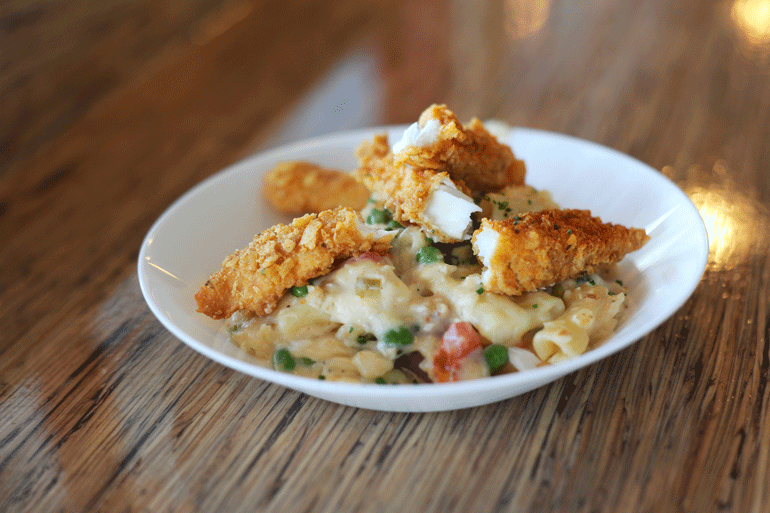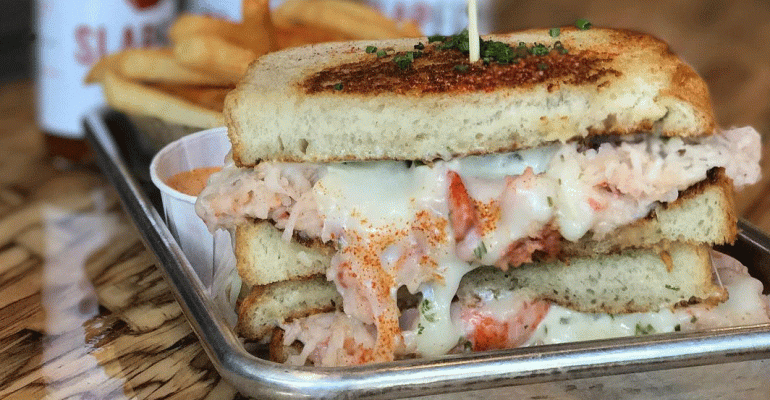Do you break the “no seafood and cheese” rule? Here’s a quick look into the origin story of that seemingly hard and fast rule, chefs who consciously object to it (with style!) and the dishes that make recklessness taste refined.
Origins in Italy, exceptions in France
There are a couple of widely cited theories as to how this rule became set in stone: First, since fish can be so delicate, and cheese can be so strong, it could be common sense. Second, since this cardinal rule originates in Italy, it could be geography: Italy’s cheese-making regions are largely landlocked, so seafood just wasn’t part of the paradigm.
“The Italians were definitely a strong voice in the horror of using cheese with a delicate seafood item, one that would obscure the clean flavors of delicate clams or shrimp,” said Brendan Walsh, dean of culinary arts at The Culinary Institute of America. “The clean, fresh taste of the sea should be shining through. Anything else would have been a somewhat boorish treatment of food.”

The seafood stuffed mushrooms at Red Lobster
But au contraire in France, the culinary zenith for many of today’s classically trained chefs, where blue cheese and mussels is considered trés bien.
And then there’s the gutsy bravado of a chef flouting the rule just because.
“They thrive on it: ‘Let’s make something totally taboo and get away with it,’” said Taylor Park, executive chef with Centerplate at Seattle’s Safeco Field.
“It does not apply to me. I broke the rule long ago because I love to be creative,” said Ozzy Amelotti, executive chef at Vivere, a modern Italian restaurant in Chicago’s Italian Village complex. “I believe that la vita dell’artista (the life of the artist) fears no rules.”

Crab & shrimp pesto risotto at Vivere
Exceptions to the rule
In a way, a new playbook has emerged for those who dare to serve fish with cheese.
“It’s really a balancing act of pairing the right combinations and textures,” said chef Dustin Hilinski of Red Lobster, the casual-dining seafood chain with over 700 locations in the U.S., Canada and internationally that’s been breaking the rule for years.
Classic Red Lobster dishes like crab-or-shrimp linguini Alfredo and seafood-stuffed mushrooms with Monterey Jack kicked things off. New menu items — lobster and langostino pizza and langostino-lobster artichoke dip with three cheeses — continue Red Lobster’s non-traditional tradition.
“You don’t want to use a cheese that will overpower the seafood, rather, it should complement and even elevate the flavor,” Hilinski said, a sentiment echoed by Alex Reyes, executive chef with Centerplate at the Javits Center in New York City.

The lobster and langostino pizza at Red Lobster
“It’s not just any kind of cheese; it’s about pairing the perfect cheese,” said Reyes, who was born in Barcelona and educated at Le Cordon Bleu. He trained at several of Washington, D.C.’s best kitchens, including Jaleo with José Andrés.
When Reyes worked at Saks Fifth Avenue, lobster ravioli with corn and ricotta was a great success, especially when the team got their hands on black or white truffles to shave on top. Lately at the Javits Center, he’s wowed at catered events with lobster risotto, making use of sharp, salty cheese like parmesan.
Pasta works as a vehicle to do the daring pairing of seafood and cheese at Grandpa Mac, the quirky, high-minded, fast-casual concept with two locations in Rehoboth Beach, Del., from chef Hari Cameron, who owns and operates Grandpa Mac with his brother, Orion Cameron.
“Like most rules, there’s always exceptions, and there’s smother versus accent,” Cameron said, describing Summer on the Cape, a mac-and-cheese with sweet poached lobster and pasta shells encased in nutty Gruyere, Gouda and nutmeg, topped with crunchy breadcrumbs.

Shrimp linguini Alfredo at Red Lobster
More exceptions in fast casual
Andrew Gruel doesn’t just flout the rule occasionally; he’s built a 13-unit (and counting, with 22 scheduled to open by the end of the year) restaurant chain on the combination, with the Clobster grilled cheese sandwich, a combo of crab, lobster and the all-important “cheese pull” of whole-milk mozzarella, topping the list of Slapfish customer favorites.
A Regal Springs tilapia mac-and-cheese LTO at Slapfish pairs fish with not one, but four different cheeses. A shrimp flatbread with chowder queso fundido for dipping has been a hit, too.
But Gruel didn’t take his rule-breaking lightly. Growing up, his busy working parents didn’t have time to pass along very many Italian cooking traditions—“Our house was more Sara Lee than hand-rolled pasta,” Gruel said—but one rule that he learned was the good old “no seafood and cheese.”

The Clobster grilled cheese at Slapfish
“That was a truism,” he said. “You don’t do cheese with seafood, and you don’t do berries with seafood. That was what I knew.”
After culinary training and starting his own business, he risked it anyway. Early on in his career, when he was just a man with a food truck showing off for various shows on the Food Network and the Cooking Channel, he created a bolder precursor to the Clobster, a sandwich that paired crab and brie.
“At the time, everyone thought we were crazy. Because it was brie…not just cheese, but the one cheese that’s relegated to crackers and jam because of how strong it is,” Gruel said, adding that breaking this rule has indeed been integral to his success as a fun, fast-casual seafood experience.
“We wanted to take it from white tablecloth to fun and whimsical, and that was the first angle: taking those traditional thoughts and shattering them,” he said.

Tilapia mac and cheese at Slapfish
A walleye swims into a sandwich shop
Melt Bar and Grilled is another fast-growing, fast-casual phenomenon with nine Ohio locations (including Melt University at Case Western Reserve University) that grew from one old storefront in the Cleveland suburb of Lakewood, Ohio.
Melt fans are so rabid that, as of this writing, about 900 of them have tattooed their bodies with a Melt-approved grilled cheese design in order to get a lifetime 25-percent discount on the decadently gooey, over-the-top sammies.
Since the beginning, in 2006, Melt has featured a seafood grilled cheese sandwich on the menu named the Lake Erie Monster. At first, walleye was used, but when that got too expensive, it was replaced by the more sustainable North Atlantic pollock. The firm, white filets are dredged in flour, batter and crunchy panko bread crumbs, then fried. A sweet slaw with cabbage and apple cider vinegar, plus housemade jalapeno tartar sauce, gives bite to the “monster,” and the cheese is…what else? American.
Matt Fish, founder of Melt Bar and Grilled, took his cue for the sandwich from the Filet-O-Fish, which includes cheese and has worked out just fine for billions and billions of satisfied McDonald’s customers.
“It’s a very classic fried fish sandwich,” he said. “American cheese is perfect, but you can sub out pepper Jack cheese, and that’s really good, but American cheese is tried and true.”
Sandwiches offer more leniency in the rule, Fish posited.
“I don’t necessarily see any issues with mixing cheese and that type of seafood (a fried patty),” Fish said. “We had a tuna melt for years that was really popular, with sushi-grade yellowfin tuna, sliced thin and paired with Muenster cheese with lettuce and tomato. Maybe we’ll bring that back this year.”





